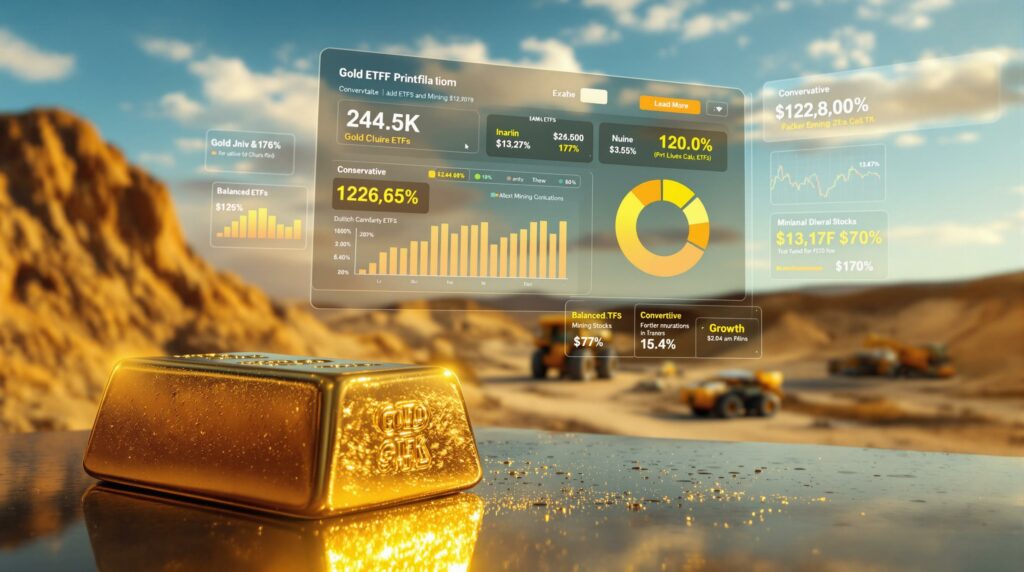Understanding Gold Investment Options: ETFs vs Mining Equities in 2025
Gold has established itself as a strategic asset class with continued strength through 2025. As investors navigate this complex market, understanding the fundamental differences between gold ETFs and mining equities becomes critical for portfolio optimization. This comprehensive analysis explores the factors driving gold prices analysis and provides frameworks for effective investment allocation strategies.
What is Driving Gold's Performance in 2025?
Macroeconomic Factors Supporting Gold Prices
Gold continues to demonstrate remarkable resilience as a strategic asset, with prices maintaining levels above $3,000 per ounce in 2025. This strength stems from several converging factors creating a uniquely supportive environment for precious metals.
Central banks worldwide have accelerated their gold purchasing programs, with many institutions adding substantial positions as part of broader reserve diversification strategies. This institutional validation establishes a demand floor supporting sustained price appreciation beyond typical retail investor interest.
The World Gold Council reports central bank purchases have remained at historically elevated levels, representing a fundamental shift in monetary policy approaches across both developed and emerging economies.
Geopolitical Tensions and Monetary Uncertainty
Ongoing trade policy friction between major economies continues driving safe-haven demand for gold. Military conflicts and diplomatic instability across multiple regions have reinforced gold's historical role as a crisis hedge.
Meanwhile, persistent inflation concerns strengthen gold's appeal as a purchasing power preservation tool. As one senior portfolio manager noted, "The structural inflation pressures haven't disappeared—they've simply evolved from supply chain disruptions to wage growth and services inflation."
With real interest rates remaining suppressed across developed markets, gold's traditional opportunity cost disadvantage has been effectively eliminated. This interest rate environment creates a particularly favorable backdrop for non-yielding assets like gold.
Long-term Structural Support
The supply-demand dynamics for gold remain favorable, with mining companies reporting increasing difficulty replacing reserves at historical cost levels. This challenge manifests in several ways:
- Declining ore grades at existing operations
- Reduced discovery rates for new deposits
- Higher capital intensity for new project development
- Extended permitting timelines in key jurisdictions
This potential supply tightness provides fundamental support for higher long-term prices, benefiting both physical gold investments and quality mining operations with established production profiles.
How Do Gold ETFs Provide Portfolio Stability?
Institutional-Grade Exposure Without Operational Complexity
Exchange-traded funds backed by physical gold bullion represent the most efficient method for gaining gold exposure without operational complexities. These instruments provide direct price tracking through vault-stored precious metals, eliminating:
- Premium costs associated with physical bullion purchases
- Storage requirements and associated security costs
- Insurance expenses for physical holdings
- Authentication concerns with direct ownership
Leading gold ETFs maintain institutional acceptability with competitive fee structures, typically charging approximately 0.15-0.40% annually depending on the specific fund structure and size.
Liquidity and Portfolio Construction Advantages
Gold ETFs offer superior liquidity compared to physical alternatives, with continuous trading during market hours and tight bid-ask spreads enabling efficient position adjustments.
This liquidity becomes particularly valuable during volatile periods when rapid portfolio rebalancing may be necessary. Market data shows gold ETF trading volumes typically spike during periods of market stress, precisely when liquidation flexibility is most valuable.
From a portfolio construction perspective, gold ETFs function as pure beta plays on gold price movements, providing predictable correlation characteristics for risk management purposes. Research consistently demonstrates gold's negative correlation with equity markets during stress periods (-0.2 to -0.4), making strategic allocations mathematically optimal for portfolio volatility reduction.
Tax Efficiency and Administrative Simplicity
The tax treatment of gold ETFs within institutional structures, particularly pension funds and endowments, offers advantages over direct ownership. Key benefits include:
- Elimination of complex capital gains calculations
- Simplified reporting requirements
- Reduced administrative overhead
- Avoidance of storage liability issues
For taxable investors, certain gold ETFs structured as grantor trusts may have different tax implications than those structured as traditional ETFs, potentially affecting after-tax returns.
What Opportunities Exist in Gold Mining Equities?
Established Producers: Operational Excellence and Cash Flow Generation
Established gold producers offer leveraged exposure to gold prices while providing operational stability and dividend potential. Companies with diversified production portfolios across multiple jurisdictions reduce single-country risk while maintaining cost advantages.
Major producers with operations across stable jurisdictions have demonstrated resilience through multiple commodity cycles. The most competitive operations maintain all-in sustaining costs (AISC) in the $1,400-1,600 per ounce range, providing substantial margins at current gold prices.
A crucial development among established producers has been the disciplined approach to capital allocation, with many companies prioritizing:
- Debt reduction during favorable price environments
- Sustainable dividend policies tied to free cash flow generation
- Measured production growth rather than expansion at any cost
- Return on invested capital as a key performance metric
This operational discipline represents a significant departure from previous gold bull markets, potentially reducing downside risk during price corrections.
Growth-Stage Producers: Expansion Leverage and Value Creation
Growth-stage gold producers offer higher potential returns through successful execution of expansion plans. Companies transitioning from smaller operations to mid-tier production levels can generate significant shareholder value through increased production volumes and improved economies of scale.
Mining operations with established infrastructure and skilled local workforces have successfully implemented sustainable mining practices while pursuing measured production growth. The most promising companies in this category demonstrate:
- Clear pathways to production expansion
- Sequential development approaches minimizing capital risk
- Exploration success adding to resource inventory
- Strong community relations and social license to operate
The transition from 50,000 ounces to 100,000+ ounces annual production often represents a critical inflection point for mining companies, with significant improvements in unit economics, market visibility, and institutional investor interest.
Development Projects: Near-Term Production Catalysts
Development-stage gold companies with near-term production potential offer compelling investment opportunities when supported by strong economics and experienced management teams.
High-grade Canadian gold projects, particularly those involving mine restarts, can achieve rapid payback periods when leveraging existing infrastructure. Companies successfully transitioning from development to production demonstrate the importance of:
- Operational validation through bulk sampling programs
- Conservative ramp-up schedules with built-in contingencies
- Experienced technical teams with specific deposit expertise
- Strong balance sheets minimizing financing risks
The derisking process from feasibility study to commercial production represents a critical value creation phase, with successful execution typically rewarded through significant share price revaluation.
Exploration Upside: District-Scale Potential
Exploration-focused gold companies offer maximum leverage to discovery success, though with correspondingly higher risk profiles. Companies with district-scale land packages in proven gold regions can systematically develop multiple targets while building resource inventories.
The most promising exploration companies demonstrate:
- Strategic land positions in established gold districts
- Methodical exploration programs with clear targeting rationales
- Technical teams with previous discovery successes
- Adequate funding for meaningful drill programs
Exploration programs targeting multi-million ounce potential, particularly those adjacent to major existing mines, provide significant upside potential beyond initial resource definitions.
How Do Risk-Return Profiles Differ Between Gold Investment Vehicles?
Volatility Characteristics Across the Investment Spectrum
The risk-return characteristics of gold investments vary significantly between ETFs and mining equities, with additional variation across mining company development stages.
Gold ETFs typically exhibit volatility similar to the underlying commodity, with standard deviation ranging 15-20% annually and correlation to gold prices exceeding 95%. This predictability makes ETFs suitable for strategic allocations focused on portfolio diversification rather than alpha generation.
Comparing the volatility profiles across investment options:
| Investment Type | Typical Volatility (vs Gold) | Key Risk Factors |
|---|---|---|
| Gold ETFs | 1.0x | Tracking error, custody risk |
| Major Producers | 1.5-2.0x | Operational execution, cost control |
| Mid-Tier Producers | 2.0-3.0x | Production growth, reserve replacement |
| Developers | 3.0-4.0x | Permitting, financing, construction |
| Explorers | 4.0-6.0x | Discovery risk, dilution, financing |
This volatility gradient provides investors with options across the risk spectrum, enabling portfolio construction aligned with specific risk tolerance and return objectives.
Mining Equity Risk-Return Gradient
Mining equities demonstrate a clear risk-return gradient based on operational maturity:
-
Established producers exhibit volatility 1.5-2.0x higher than gold prices, with operational diversification reducing company-specific risks. These companies typically offer dividend yields of 1-3% while maintaining substantial operational leverage to gold prices.
-
Growth-stage producers show volatility 2.0-3.0x gold price movements but with substantial leverage to price appreciation. Their expansion projects often provide clear catalysts for near-term revaluation independent of gold price movements.
-
Development companies demonstrate volatility 3.0-4.0x gold prices, with binary outcomes dependent on successful project execution. Significant revaluation potential exists as companies transition from development to production.
-
Exploration companies represent the highest risk-return category, with potential for 5-10x returns during discovery success but also substantial loss potential. The challenge for investors lies in identifying companies with both technical merit and financial capacity to advance discoveries.
Optimizing Risk-Adjusted Returns
Sophisticated gold investors optimize risk-adjusted returns by combining stability-focused ETF exposure with carefully selected mining equities. This approach provides both downside protection during market stress and upside participation during strong gold markets.
The relative allocation between ETFs and mining equities should reflect individual risk tolerance, with more conservative investors favoring higher ETF weightings and growth-oriented investors increasing mining equity exposure.
A balanced approach might include:
- 50% core position in gold ETFs
- 30% in established and growth-stage producers
- 20% in development and exploration companies with exceptional risk-reward profiles
This structure provides meaningful participation in gold's upside potential while maintaining sufficient ballast during volatile periods.
What Strategic Allocation Models Work Best for Gold Investments?
Conservative Allocation Framework (60% ETF / 40% Mining)
Conservative gold investment strategies emphasize stability while maintaining moderate growth potential:
- 60% allocation to gold ETFs provides portfolio foundation with predictable correlation benefits
- 25% allocation to established producers with proven operational track records
- 10% allocation to growth-stage producers with clear expansion plans
- 5% allocation to select development/exploration companies with exceptional risk-reward profiles
This approach prioritizes capital preservation while allowing participation in gold price appreciation through carefully selected mining exposures. The substantial ETF allocation ensures portfolio stability during market corrections, while the mining equity component provides enhanced returns during gold bull markets.
The conservative framework is particularly appropriate for:
- Near-retirement investors seeking inflation protection
- Institutional allocations with lower risk tolerance
- Foundation and endowment portfolios with preservation mandates
Balanced Allocation Framework (50% ETF / 50% Mining)
Balanced gold investment strategies seek equilibrium between stability and growth potential:
- 50% allocation to gold ETFs maintains substantial portfolio protection
- 25% allocation to established producers for dividend potential and operational stability
- 15% allocation to growth-stage producers for expansion leverage
- 10% allocation to development/exploration companies for discovery upside
This framework provides meaningful upside participation while maintaining sufficient ETF exposure for portfolio protection during market stress. The equal weighting between ETFs and mining equities creates a balanced approach to gold sector exposure.
The balanced framework serves:
- Mid-career investors building wealth
- Family offices with moderate risk tolerance
- Institutional investors seeking enhanced returns with controlled volatility
Growth-Oriented Allocation Framework (30% ETF / 70% Mining)
Growth-focused gold investment strategies maximize upside potential while maintaining a foundation of stability:
- 30% allocation to gold ETFs provides baseline protection
- 30% allocation to established producers for operational stability
- 25% allocation to growth-stage producers for near-term expansion
- 15% allocation to development/exploration for maximum leverage
This approach emphasizes capital appreciation through mining equity exposure while maintaining sufficient ETF allocation to moderate overall portfolio volatility. The higher mining equity allocation provides enhanced returns during gold bull markets, though with correspondingly higher volatility.
The growth framework is suited for:
- Younger investors with long time horizons
- High net worth individuals with higher risk tolerance
- Specialized natural resource funds seeking sector alpha
What Operational Metrics Matter Most When Evaluating Gold Miners?
Resource Quality and Reserve Sustainability
Resource quality represents a fundamental evaluation criterion for mining investments. Key metrics include:
- Grade (grams per tonne): Higher grades typically correlate with better economics and operational flexibility
- Strip ratios for open-pit operations: Lower strip ratios (waste-to-ore) improve cost structures
- Metallurgical recovery rates: Higher recovery percentages improve project economics
- Mine life sustainability: Longer mine lives reduce reinvestment risk
Companies demonstrating superior resource conversion from inferred to measured and indicated categories, and ultimately to reserves, provide greater investment certainty. High-grade deposits (>5 g/t Au) typically offer superior economics and greater resilience during price downturns.
Exploration success on existing properties represents a particularly valuable form of organic growth, as it leverages existing infrastructure and operational expertise while extending mine life and potentially expanding production profiles.
Cost Structure and Operational Efficiency
All-in sustaining costs (AISC) provide the most comprehensive efficiency measure across mining operations. This standardized metric includes:
- Direct mining and processing costs
- Sustaining capital expenditures
- Corporate G&A allocation
- Exploration expenditures
- Reclamation accruals
Competitive AISC ranges of $1,400-1,600/oz for established operations represent industry benchmarks, though this varies by jurisdiction and mining method.
Environmental performance metrics, including carbon intensity (tCO₂e/oz), water usage, and rehabilitation practices, increasingly influence operational sustainability and regulatory risk profiles. Companies demonstrating superior environmental management often receive preferential treatment during permitting processes and maintain stronger community support.
Management Capability and Execution History
Management teams with demonstrated track records of successful project development and operational execution reduce execution risk significantly. Key indicators include:
- Previous success in similar geological settings
- On-time and on-budget project delivery
- Operational optimization achievements
- Effective capital allocation decisions
Companies consistently meeting or exceeding production guidance and cost targets demonstrate superior operational control and management capability. Conversely, frequent guidance revisions often indicate underlying management or operational issues.
Management ownership alignment provides an additional indicator of interests aligned with shareholders. Executives with meaningful equity positions tend to make decisions with longer-term value creation in mind.
Jurisdictional Considerations and Infrastructure Access
Political stability, regulatory predictability, and infrastructure quality significantly impact mining investment risks. Operations in Tier 1 jurisdictions like Canada, Australia, and the United States benefit from established mining codes and predictable permitting processes.
However, well-managed operations in stable emerging markets with established mining sectors can offer superior economics while maintaining acceptable risk profiles when operated by experienced teams with local expertise.
Critical infrastructure considerations include:
- Power availability and cost
- Water access and management
- Transportation infrastructure for supplies and product
- Skilled labor availability and training facilities
Companies developing projects in remote locations face additional challenges requiring specialized expertise and contingency planning, particularly regarding logistics and workforce management.
What Tactical Considerations Should Guide Gold Investment Timing?
Current Market Positioning and Entry Opportunities
Current market conditions present strategic entry opportunities across multiple gold investment vehicles. Technical analysis indicates gold prices above $3,000/oz reflect strong fundamental support rather than speculative excess, with institutional demand providing price floors during potential corrections.
Mining equity valuations demonstrate reasonable multiples relative to historical averages, particularly when adjusted for current gold price levels and operational improvements. Key valuation metrics to monitor include:
- Price-to-NAV ratios (P/NAV)
- Enterprise value to EBITDA (EV/EBITDA)
- Price-to-cash flow multiples (P/CF)
- Free cash flow yields
These metrics should be evaluated relative to both historical ranges and peer group comparisons to identify relative value opportunities.
Company-Specific Catalyst Timelines
Individual mining companies face distinct catalyst timelines requiring tactical position management:
-
Production ramp-up periods following mine commissioning provide near-term operational milestones that can drive significant revaluation. The transition from construction to commercial production represents a critical derisking phase often accompanied by multiple valuation inflection points.
-
Major expansion projects with defined timelines to first gold production offer medium-term growth catalysts. Successful expansions can significantly improve company economics through increased production scale and improved unit costs.
-
Ongoing exploration programs with regular news flow create continuous discovery potential that can drive valuation increases independent of gold price movements. Systematic drill programs expanding resource inventories represent a key value creation mechanism, particularly for earlier-stage companies.
-
Reserve/resource updates provide periodic revaluation catalysts as companies convert exploration success into formal resource categories. The progression from initial discovery to defined resources represents a critical value creation pathway.
Seasonal Patterns and Cyclical Considerations
Gold investments historically demonstrate seasonal strength during Q4 and Q1 periods, driven by jewelry demand cycles and institutional portfolio rebalancing. Mining equities often exhibit stronger performance during proven operational periods, suggesting tactical overweighting during production guidance achievement phases.
Counter-cyclical positioning during periods of market pessimism can provide superior entry points for long-term strategic allocations. Undervalued gold stocks frequently experience volatility spikes creating tactical opportunities for patient investors focused on fundamental value.
The relationship between gold and real interest rates represents an important tactical consideration, with negative correlations historically strongest during periods of declining real rates. Monitoring bond market developments provides important context for [gold market resurgence
Ready to Spot the Next Major Mineral Discovery?
Don't miss potential investment opportunities in the mining sector! Discovery Alert's proprietary Discovery IQ model instantly notifies investors of significant ASX mineral discoveries, turning complex data into actionable insights. Visit the Discovery Alert discoveries page to understand why major mineral discoveries can lead to exceptional market returns.




